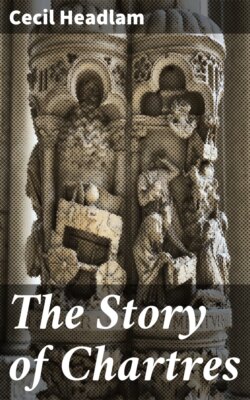The Story of Chartres

Реклама. ООО «ЛитРес», ИНН: 7719571260.
Оглавление
Cecil Headlam. The Story of Chartres
The Story of Chartres
Table of Contents
ILLUSTRATIONS
CHAPTER I. Druids and Romans: The Crypt
Le Puits des Saints Forts
Crypt: Notre-Dame-de-Sous-Terre
CHAPTER II. Saints and Barbarians
Church of S. Aignan
S. Martin-au-Val,
The Veil of the Virgin—The Cathedral Treasury
CHAPTER III. Theobald-the-Trickster and Fulbert the Bishop
CHAPTER IV. S. Ives and the Crusades
CHAPTER V. The Cathedral and Its Builders
CHAPTER VI. Mediæval Glass and Mediæval Guilds
CHAPTER VII. The Cathedral
CHAPTER VIII. The Birth of the Bourgeoisie and the English Occupation
CHAPTER IX. The Siege and the Breach, 1568
CHAPTER X. Mathurin Regnier and the Renaissance at Chartres
CHAPTER XI. The Coronation of Henri Quatre
CHAPTER XII. The Revolution—S. Père
CHAPTER XIII. The Prussians at Chartres
CHAPTER XIV. Itinerary and Expeditions
Expeditions
Dates of the Chief Festivals at Chartres
INDEX
Отрывок из книги
Cecil Headlam
Published by Good Press, 2019
.....
Meanwhile, when Augustus gave laws to the conquests of Cæsar, he introduced a division of Gaul equally adapted to the progress of the legions, to the course of the rivers and to the principal national distinctions, which had comprehended above a hundred independent states. The Province in which Chartres (Autricum) now found itself embraced the country between the Loire and the Seine, and was styled Celtic Gaul, or, as it soon came to be known, Gallia Lugdunensis, borrowing its name from the celebrated colony of Lugdunum or Lyons. The principal towns of this Province were still Chartres, Dreux, and, above all, Orléans, to which the Emperor Aurelian was later on to give his name when he separated it from the territory of the Carnutes, and raised it to the rank of a city. For the rest, there were a great number of villages and strongholds even in Cæsar’s day scattered about in the clearings of the forest. These would increase in size and importance as the great Roman roads running from Dieppe to Dreux, from Rouen to Paris, and from Paris to Autun, were built, and as the country grew more settled. For Druidism, which had long shown itself a disturbing influence and an irreconcilable factor, was at length proscribed by Tiberius and Claudius, and thereafter, Dion Cassius assures us, the Loire could be navigated in as much security as the Po or Rhone. ‘The blue waters of the fair-haired Carnutan’ grew familiar, not only to the Roman merchant and official, but also to the Roman poet and traveller.[7]
But if the legend of the Druidical Virgin be indeed true, it would appear that the Druids, equally with the Romans, had done something to prepare the soil for the seed of Christianity. As to the first sowers of that seed there is some dispute, and also as to the first sowing, which some date from the first century, others from the third.
.....